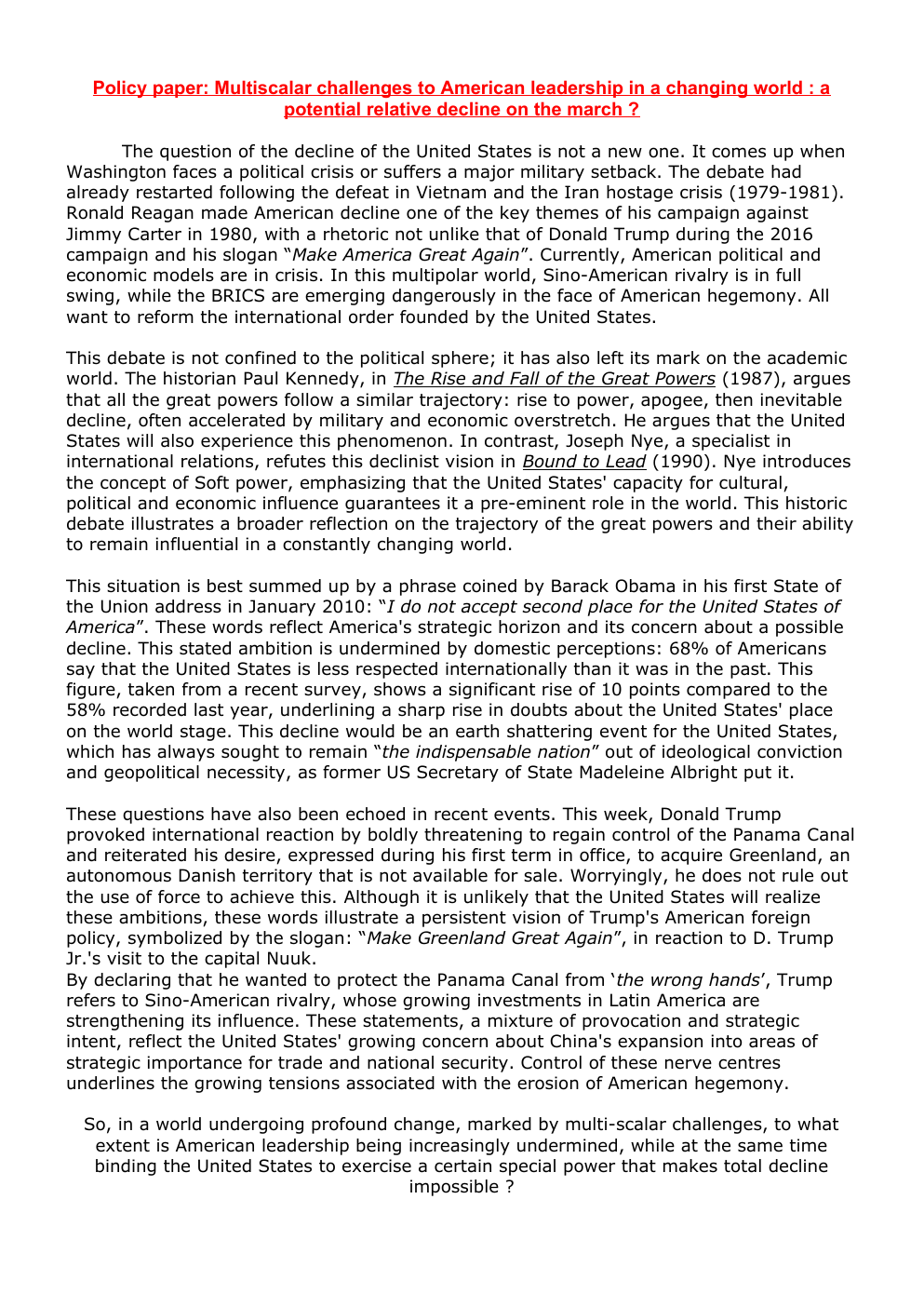Policy Paper - Policy paper: Challenges to American leadership in a changing world : a potential relative decline on the march ?
Publié le 19/10/2025
Extrait du document
«
Policy paper: Multiscalar challenges to American leadership in a changing world : a
potential relative decline on the march ?
The question of the decline of the United States is not a new one.
It comes up when
Washington faces a political crisis or suffers a major military setback.
The debate had
already restarted following the defeat in Vietnam and the Iran hostage crisis (1979-1981).
Ronald Reagan made American decline one of the key themes of his campaign against
Jimmy Carter in 1980, with a rhetoric not unlike that of Donald Trump during the 2016
campaign and his slogan “Make America Great Again”.
Currently, American political and
economic models are in crisis.
In this multipolar world, Sino-American rivalry is in full
swing, while the BRICS are emerging dangerously in the face of American hegemony.
All
want to reform the international order founded by the United States.
This debate is not confined to the political sphere; it has also left its mark on the academic
world.
The historian Paul Kennedy, in The Rise and Fall of the Great Powers (1987), argues
that all the great powers follow a similar trajectory: rise to power, apogee, then inevitable
decline, often accelerated by military and economic overstretch.
He argues that the United
States will also experience this phenomenon.
In contrast, Joseph Nye, a specialist in
international relations, refutes this declinist vision in Bound to Lead (1990).
Nye introduces
the concept of Soft power, emphasizing that the United States' capacity for cultural,
political and economic influence guarantees it a pre-eminent role in the world.
This historic
debate illustrates a broader reflection on the trajectory of the great powers and their ability
to remain influential in a constantly changing world.
This situation is best summed up by a phrase coined by Barack Obama in his first State of
the Union address in January 2010: “I do not accept second place for the United States of
America”.
These words reflect America's strategic horizon and its concern about a possible
decline.
This stated ambition is undermined by domestic perceptions: 68% of Americans
say that the United States is less respected internationally than it was in the past.
This
figure, taken from a recent survey, shows a significant rise of 10 points compared to the
58% recorded last year, underlining a sharp rise in doubts about the United States' place
on the world stage.
This decline would be an earth shattering event for the United States,
which has always sought to remain “the indispensable nation” out of ideological conviction
and geopolitical necessity, as former US Secretary of State Madeleine Albright put it.
These questions have also been echoed in recent events.
This week, Donald Trump
provoked international reaction by boldly threatening to regain control of the Panama Canal
and reiterated his desire, expressed during his first term in office, to acquire Greenland, an
autonomous Danish territory that is not available for sale.
Worryingly, he does not rule out
the use of force to achieve this.
Although it is unlikely that the United States will realize
these ambitions, these words illustrate a persistent vision of Trump's American foreign
policy, symbolized by the slogan: “Make Greenland Great Again”, in reaction to D.
Trump
Jr.'s visit to the capital Nuuk.
By declaring that he wanted to protect the Panama Canal from ‘the wrong hands’, Trump
refers to Sino-American rivalry, whose growing investments in Latin America are
strengthening its influence.
These statements, a mixture of provocation and strategic
intent, reflect the United States' growing concern about China's expansion into areas of
strategic importance for trade and national security.
Control of these nerve centres
underlines the growing tensions associated with the erosion of American hegemony.
So, in a world undergoing profound change, marked by multi-scalar challenges, to what
extent is American leadership being increasingly undermined, while at the same time
binding the United States to exercise a certain special power that makes total decline
impossible ?
To understand the current predicament the United States of America finds itself in and
whether the country is in decline or not we first need to understand the context behind its
rise to global hegemony and how it has managed to stay at the top for the past century.
To
start things off we will look at the very foundations of the USA’s power, its geography,
which as expected has a massive influence on Washington D.C.
's success.
The USA finds itself on the North American continent, having declared independence in
1776, it had a massive landmass left ripe for the taking which started with the Louisiana
purchase in 1803.
For the coming century the mythical frontier saw millions of people push
to the Western seaboard, a push to “Manifest Destiny”.
This did grant the American
economy all of the resources it might ever need for the longest of times, in 1945 the USA
accounted for a rough 90% of the world’s entire oil production.
It also allowed it to have
access to both the Pacific and Atlantic oceans which proved to be crucial for the
development of trade in the later centuries.
The numerous issues due to the size of the
territory were addressed since the nation's founding through the construction of critical
infrastructure, such as the Interstate system in 1956 through the Federal Aid Highway Act
or rail transport, later on replaced by the airplane or the expansion of waterways such as
the Erie canal built in 1825.
The XXth century is usually referred to as the “American century”, a term coined by
the journalist Henry Luce in the Times magazine in 1941.
From 1947 onwards, Washington
locked itself in a Cold War against the Soviet Union.
This conflict did lead to three doctrines
being developed under the Truman or Eisenhower presidencies, the first is the Truman
doctrine consisting in helping financially a war torn Europe to prevent them from turning to
communism ; after that was theorized the containment policy, where Washington continued
promising to supply other countries with military and financial aid as long as they stood
against the communists.
In the end this was all wrapped up in the domino theory, which
explained that if one country falls to communism all of the neighboring ones would follow
suit.
The American century also saw the construction of the United Nations and other
international organizations.
These institutions enshrined American influence but also its
power on a new world order under the guidance of the Bretton Woods system, and later the
Washington Consensus.
This new found power would be seen mostly in 1991 with the
collapse of the USSR and the beginning of a new chapter of the “Pax Americana”, where
Washington D.C.
would become the “world police” under the guise of President Bush Sr.
while working tightly with the United Nations, a phenomena that started in early 1991 with
the Gulf War (1990-1991).
The United States’ power is based on strategic pillars that have not changed for almost
8 decades now.
One of the infamous strategic pillars of the United States today is its
foreign policy.
It is based on ensuring the safety of American lives and territory through
robust military defense.
While also preventing any single power or coalition from
dominating key global regions.
Addressing threats from hostile non-state actors such as
terrorists, drug cartels, and pirates through law enforcement and military operations.
Strengthening weak states to prevent threats from arising by fostering accountable
governance, economic development, and stability in conflict-prone areas.
And finally democracy promotion as a means to align with American values and create
stable cooperation.
In 2003, President Bush Jr.
declared war on Iraq to start the process of
democratic contagion under the guidance of Washington.
But there's more when it comes
to the strategic pillars of the United States, like their economic strength.
The United States is a global leader in technology and innovation, with companies like
GAFAM, and Tesla setting industry standards.
A strong economy ensures economic
resilience and global competitiveness.
Their currency serves also as the world’s primary
reserve currency.
But they are also at the forefront of technological innovation, setting
international benchmarks.
Their diplomatic influence, particularly in terms of alliances, and their participation in
international institutions, round off the picture.
All of these pillars, despite their global nature, are in line with a primacy objective.
A goal
that is both a memory and an aspiration for the United States.
Those pillars were built
along with the history of the United States and as signs of weakness showed the power of
the USA was always put back into question.
As we have looked at every single foundation of the USA’s preeminence in the
modern world, we also need to look as to why the American public believes the USA is in
decline and how it may be harnessed by certain politicians.
Since the end of the Second World War, the Americans have believed that they are in
decline with numerous decades being landmarks of this line of thought, between 1950s and
1980s, and more recently the 2010s and....
»
↓↓↓ APERÇU DU DOCUMENT ↓↓↓
Liens utiles
- How did Roosevelt address the challenges of the Great Depression ?
- Musical Instruments I INTRODUCTION World Music Tour Click on the instruments to hear music from around the world.
- Edmund Burke, Speech on Conciliation with the Colonies, 22 March 1775
- San Marino is the oldest republic in the world, its constitution datesfrom 1569.
- The Declaration of IndependenceIn the summer of 1776, more than a year after American colonists had begun their rebellion against Great Britain, the Second Continental Congress debated a resolution forindependence.


